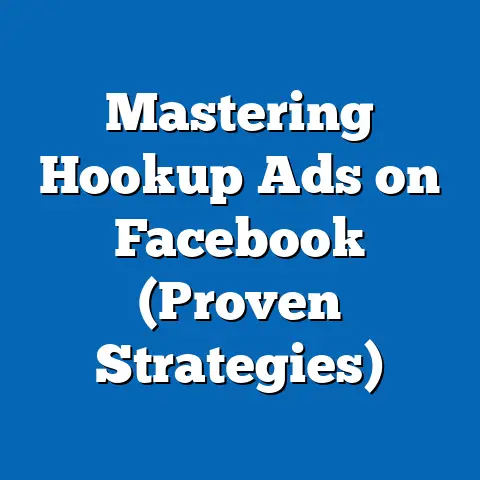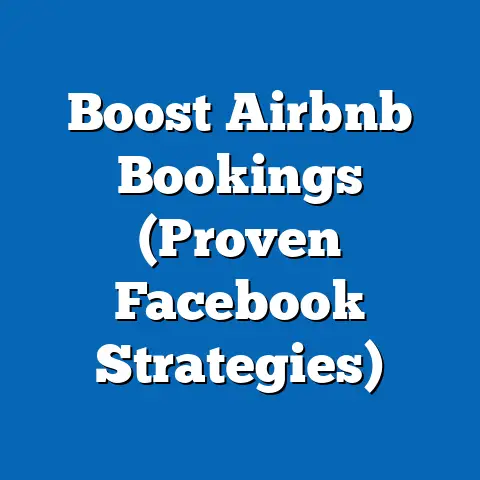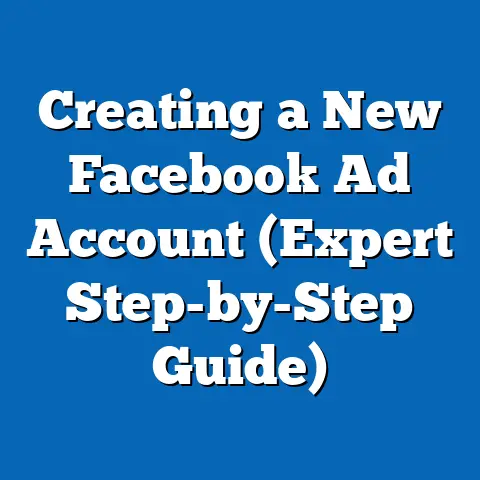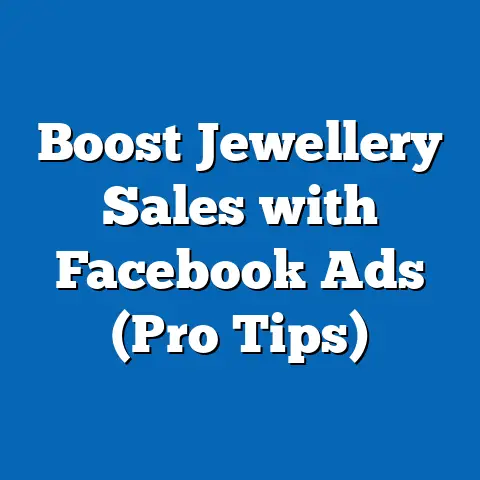Master Facebook Ad Deletion (Essential Guide for Marketers)
We live in a digital age where businesses are pouring significant resources into digital marketing, and Facebook advertising has become a cornerstone of many marketing strategies. I’ve seen firsthand how companies allocate substantial budgets to create and run Facebook ads, viewing them as a critical component for reaching their target audience and driving conversions. But, here’s the thing: creating effective ads is only half the battle. Managing and, yes, even deleting underperforming or irrelevant ads is equally important.
Think of it like tending a garden. You plant seeds (create ads), nurture them (optimize targeting and bidding), and watch them grow (track performance). But just as a gardener must prune dead or diseased branches to allow the healthy plants to thrive, a marketer must be willing to cut ties with ads that aren’t delivering results. Leaving those underperforming ads running is like watering weeds – it drains resources and prevents your best ads from flourishing. This is where the art and science of Facebook ad deletion come into play.
In this guide, I’ll walk you through everything you need to know about mastering Facebook ad deletion. We’ll cover why it’s crucial, how to identify ads that need to go, the step-by-step process of deleting them, and even the potential consequences you need to be aware of. My goal is to equip you with the knowledge and confidence to proactively manage your ad account and ensure that every dollar you spend is working hard for your business.
Understanding Facebook Ads
Before diving into the deletion process, let’s take a quick refresher on Facebook ads and their role in digital marketing. Facebook ads are, simply put, paid messages that businesses use to reach specific audiences on the Facebook platform (which now encompasses Instagram, Messenger, and the Audience Network). They’re a powerful tool for driving brand awareness, generating leads, and ultimately, increasing sales.
I’ve worked with businesses of all sizes, and one thing remains constant: the effectiveness of Facebook ads hinges on understanding the different ad types and their intended purposes. Here’s a brief overview:
- Image Ads: The simplest form, featuring a single image and accompanying text. These are great for showcasing products or services visually.
- Video Ads: Engaging and dynamic, video ads capture attention and can tell a more compelling story than static images.
- Carousel Ads: Showcase multiple images or videos in a scrolling format, perfect for highlighting different features of a product or telling a sequential story.
- Collection Ads: Designed for mobile devices, these ads combine a hero image or video with several product images below, creating a visually appealing shopping experience.
No matter the ad type, tracking performance is paramount. Facebook Ads Manager provides a wealth of data to help you gauge the effectiveness of your campaigns. Key metrics to watch include:
- Click-Through Rate (CTR): The percentage of people who saw your ad and clicked on it. A higher CTR indicates that your ad is relevant and engaging.
- Conversions: The number of people who took a desired action after seeing your ad, such as making a purchase, filling out a form, or signing up for a newsletter.
- Engagement: Measures how people interact with your ad, including likes, comments, shares, and saves. High engagement suggests that your ad resonates with your audience.
- Return on Ad Spend (ROAS): The amount of revenue generated for every dollar spent on advertising. A high ROAS indicates that your ad campaigns are profitable.
Takeaway: Understanding the different types of Facebook ads and tracking key performance metrics is crucial for effective campaign management and informed decision-making.
The Importance of Ad Deletion
Now, let’s get to the heart of the matter: why is deleting Facebook ads so important? It’s a question I often get asked, and the answer is multifaceted. While creating compelling ads is undoubtedly essential, neglecting the management and deletion of underperforming ads can have a detrimental impact on your overall advertising efforts.
One of the biggest benefits of deleting ads is maintaining an efficient ad account. A cluttered ad account, filled with dozens or even hundreds of ads, can quickly become overwhelming. I’ve seen this firsthand with clients who have been running campaigns for years without ever pruning their ad accounts. The result? Confusion, inefficiency, and a significant waste of time trying to navigate through a sea of irrelevant ads.
Deleting poor-performing ads also plays a crucial role in refining your audience targeting. By removing ads that are consistently failing to resonate with your target audience, you can narrow your focus and improve the overall relevance of your campaigns. Think of it as a process of continuous refinement. Each ad deletion is a learning opportunity that helps you better understand your audience and what resonates with them.
Furthermore, deleting underperforming ads can significantly improve the effectiveness of your future campaigns. By identifying what didn’t work, you can avoid making the same mistakes again and focus on strategies that have proven to be successful. It’s about learning from your failures and using that knowledge to create more effective ads in the future.
I recall a specific instance where a client was struggling to achieve their desired ROAS. Upon reviewing their ad account, I discovered a significant number of ads that were generating minimal engagement and conversions. After a thorough analysis, we identified several ads that were targeting the wrong audience, using outdated creative, or simply failing to deliver a compelling message. By deleting these underperforming ads and focusing on optimizing the remaining campaigns, we were able to significantly improve their ROAS and achieve their desired results.
Takeaway: Deleting Facebook ads is crucial for maintaining an efficient ad account, refining audience targeting, and improving the effectiveness of future campaigns. Don’t be afraid to prune your ad account regularly to ensure that every ad is working hard for your business.
Criteria for Deleting Ads
So, how do you decide which ads to delete? It’s not always a clear-cut decision, but there are several key criteria that I use to evaluate ad performance and determine whether an ad should be removed from the rotation.
-
Low Engagement Rates: If an ad is consistently generating minimal engagement, such as likes, comments, shares, or saves, it’s a sign that it’s not resonating with your audience. A low engagement rate suggests that your ad is either not relevant to your target audience or that the creative is not compelling enough to capture their attention.
-
High Cost Per Result: This is a critical metric to watch. If an ad is costing you significantly more than your target cost per result (e.g., cost per lead, cost per purchase), it’s a clear indication that it’s not performing efficiently. A high cost per result can be caused by a variety of factors, including poor targeting, low-quality creative, or a lack of relevance to your audience.
-
Ads That Don’t Align with Current Marketing Goals: Marketing goals evolve, and your ads should evolve with them. If an ad was created to promote a specific product or service that is no longer a priority, or if it targets an audience that is no longer relevant to your business, it’s time to consider deleting it.
-
Audience Fatigue and Ad Relevance: Even the most effective ads can lose their effectiveness over time as your audience becomes fatigued by seeing them repeatedly. If you notice a decline in performance, such as a lower CTR or a higher cost per result, it’s a sign that your audience is experiencing ad fatigue and that it’s time to refresh your creative or delete the ad altogether.
Low Engagement Rates: If an ad is consistently generating minimal engagement, such as likes, comments, shares, or saves, it’s a sign that it’s not resonating with your audience. A low engagement rate suggests that your ad is either not relevant to your target audience or that the creative is not compelling enough to capture their attention.
High Cost Per Result: This is a critical metric to watch. If an ad is costing you significantly more than your target cost per result (e.g., cost per lead, cost per purchase), it’s a clear indication that it’s not performing efficiently. A high cost per result can be caused by a variety of factors, including poor targeting, low-quality creative, or a lack of relevance to your audience.
Ads That Don’t Align with Current Marketing Goals: Marketing goals evolve, and your ads should evolve with them. If an ad was created to promote a specific product or service that is no longer a priority, or if it targets an audience that is no longer relevant to your business, it’s time to consider deleting it.
Audience Fatigue and Ad Relevance: Even the most effective ads can lose their effectiveness over time as your audience becomes fatigued by seeing them repeatedly. If you notice a decline in performance, such as a lower CTR or a higher cost per result, it’s a sign that your audience is experiencing ad fatigue and that it’s time to refresh your creative or delete the ad altogether.
Assessing these criteria is easy within Facebook Ads Manager. I typically create custom columns in the Ads Manager interface to display the metrics that are most important to me. This allows me to quickly scan my ad account and identify ads that are underperforming.
For example, I might create a column that displays the following metrics:
- Impressions
- Clicks
- CTR
- Cost Per Click (CPC)
- Conversions
- Cost Per Conversion
By sorting these columns, I can quickly identify ads with low CTRs, high CPCs, or high cost per conversions. These are the ads that I’ll typically target for deletion.
Takeaway: Use these criteria – low engagement, high cost per result, misalignment with marketing goals, and audience fatigue – to identify ads that are dragging down your performance. Regularly review your ad account and don’t hesitate to remove ads that aren’t meeting your standards.
Step-by-Step Guide to Deleting Facebook Ads
Now that you know why and when to delete ads, let’s walk through the how. Deleting Facebook ads is a straightforward process, but it’s important to follow the steps carefully to avoid accidentally deleting the wrong ads.
-
Access Ads Manager: The first step is to access Facebook Ads Manager. You can do this by navigating to your Facebook business page and clicking on the “Ads Manager” button in the left-hand menu. Alternatively, you can go directly to
facebook.com/adsmanager. -
Navigate to the Relevant Section: Once you’re in Ads Manager, you’ll need to navigate to the relevant section. You can delete ads at the campaign, ad set, or ad level. To delete an ad, click on the “Ads” tab.
-
Select the Ads to Delete: Now, you’ll need to select the ads that you want to delete. You can do this by checking the box next to each ad. If you want to delete multiple ads at once, you can use the “Bulk Select” option to select all ads within a specific campaign or ad set.
-
Click the “Delete” Button: Once you’ve selected the ads you want to delete, click on the “Delete” button. This button is typically located in the top menu bar.
-
Confirm Deletion: After clicking the “Delete” button, you’ll be prompted to confirm your deletion. Be sure to carefully review the list of ads that you’re about to delete to ensure that you’re not accidentally deleting the wrong ads. Once you’re confident that you’ve selected the correct ads, click the “Confirm” button.
Access Ads Manager: The first step is to access Facebook Ads Manager. You can do this by navigating to your Facebook business page and clicking on the “Ads Manager” button in the left-hand menu. Alternatively, you can go directly to facebook.com/adsmanager.
Navigate to the Relevant Section: Once you’re in Ads Manager, you’ll need to navigate to the relevant section. You can delete ads at the campaign, ad set, or ad level. To delete an ad, click on the “Ads” tab.
Select the Ads to Delete: Now, you’ll need to select the ads that you want to delete. You can do this by checking the box next to each ad. If you want to delete multiple ads at once, you can use the “Bulk Select” option to select all ads within a specific campaign or ad set.
Click the “Delete” Button: Once you’ve selected the ads you want to delete, click on the “Delete” button. This button is typically located in the top menu bar.
Confirm Deletion: After clicking the “Delete” button, you’ll be prompted to confirm your deletion. Be sure to carefully review the list of ads that you’re about to delete to ensure that you’re not accidentally deleting the wrong ads. Once you’re confident that you’ve selected the correct ads, click the “Confirm” button.
Bulk Deletion vs. Single Deletion:
- Bulk Deletion: This is the fastest way to delete multiple ads at once. Simply select all the ads you want to delete and click the “Delete” button.
- Single Deletion: This is a more cautious approach that allows you to review each ad before deleting it. This is a good option if you’re unsure about whether or not to delete a particular ad.
Important Note: Deleted ads cannot be recovered. Once you delete an ad, it’s gone for good. Be sure to carefully review your selections before confirming the deletion.
Screenshot Example (Illustrative):
Imagine a screenshot of the Facebook Ads Manager interface. The “Ads” tab is highlighted, and several ads are listed in the table. Checkboxes are visible next to each ad, and some are checked. The “Delete” button is circled at the top of the screen.
Takeaway: Deleting Facebook ads is a straightforward process, but it’s important to be careful and double-check your selections before confirming the deletion. Always remember that deleted ads cannot be recovered.
Consequences of Deleting Ads
While deleting underperforming ads is generally a good practice, it’s important to be aware of the potential consequences. Deleting ads is not without its risks, and it’s crucial to weigh these risks against the benefits before taking action.
One of the primary consequences of deleting ads is the loss of data for future reference. When you delete an ad, you lose all of the data associated with that ad, including its performance metrics, targeting information, and creative assets. This data can be valuable for analyzing what didn’t work and why, providing insights for future campaigns.
I’ve learned the hard way that even seemingly insignificant data points can be valuable in the long run. I once deleted a series of ads that were performing poorly, only to later realize that they were targeting a niche audience that I had overlooked. By deleting those ads, I lost valuable data that could have helped me refine my targeting strategy.
Furthermore, deleting ads can have an impact on ongoing campaigns. If you delete an ad that is part of an active campaign, you may disrupt the campaign’s performance and cause it to underperform. It’s important to carefully consider the impact of deleting an ad on your overall campaign strategy before taking action.
However, these consequences can be mitigated with proper documentation. I recommend creating a spreadsheet or document to track all of the ads that you delete, along with the reasons for deleting them. This will allow you to preserve the data associated with those ads and refer back to it in the future.
Additionally, it’s important to remember that deleted ads can always be re-evaluated in the future based on shifts in marketing strategy or audience. Just because an ad didn’t work in the past doesn’t mean that it won’t work in the future. Keep an open mind and be willing to experiment with different strategies.
Takeaway: While deleting ads can have some negative consequences, these can be mitigated with proper documentation and a willingness to re-evaluate your strategies. Don’t be afraid to delete ads that aren’t performing well, but be sure to do so thoughtfully and strategically.
Conclusion
Mastering Facebook ad deletion is not just about removing underperforming ads; it’s about proactively managing your ad account to ensure that every dollar you spend is working hard for your business. By regularly reviewing your ad performance and taking necessary actions for optimization, including deletions, you can significantly improve your ROAS and achieve your marketing goals.
I’ve seen firsthand how a well-managed ad account can transform a business’s bottom line. By embracing the principles outlined in this guide, you can take control of your Facebook advertising and unlock its full potential.
So, what are your next steps? I encourage you to take some time to review your ad account and identify any ads that are underperforming. Use the criteria outlined in this guide to determine whether those ads should be deleted. And don’t be afraid to experiment with different strategies to see what works best for your business.
Remember, Facebook advertising is a constantly evolving landscape. What works today may not work tomorrow. But by staying informed, being proactive, and embracing the principles of ad deletion, you can stay ahead of the curve and achieve your marketing goals.
Now, go forth and prune your ad account! Your bottom line will thank you.






